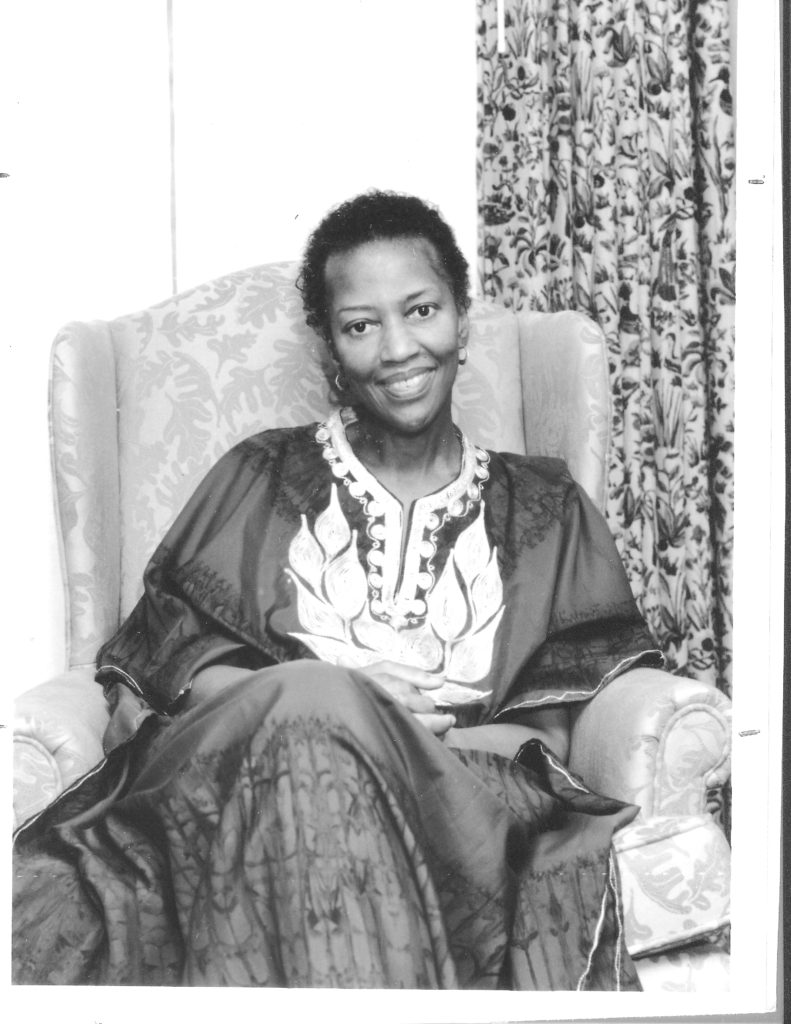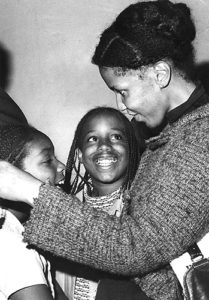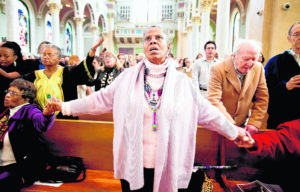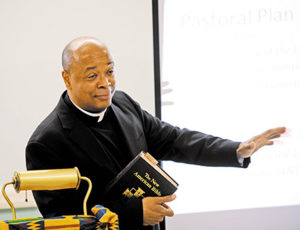Thea Bowman: A Black Nun for Sainthood
A nun who challenged the Catholic Church's racial injustices and her journey to sainthood.

Sister Thea Bowman
Thirty years ago, at the 1989 United States Conference of Catholic Bishops, Sister Thea Bowman told a room full of Catholic leaders what it meant to be black and Catholic in America. Bowman, who was in the final stages of her battle with cancer, sat in a wheelchair, her bright caftan hanging loosely around her small frame, and the post-chemotherapy remains of her thick hair framing her face in soft and sparse curls. She would die the next year at age 52.
Last year, the Conference of Catholic Bishops appointed Reverend Maurice Nutt to examine Bowman’s life, the first step toward her candidacy for sainthood. If canonized, Bowman would become one of the few black saints in the Catholic church. But the journey to sainthood is not an easy one. The process requires the candidate to have lived a life in the service of God and the Church, to have possessed “purity of doctrine,” and to have had an intercession that resulted in a miracle. The process can take decades — for Cardinal John Henry Newman, who was canonized in October 2019, the journey started over 60 years ago, in 1958.
The possibility of Bowman’s sainthood initially began in 1995. But several Church leaders said it was too soon after her death to pursue canonization. But when Bishop Joseph R. Kopacz joined Bowman’s home diocese in Jackson, Mississippi a few years ago, her name came up again for sainthood. This time it stuck. Bishop Kopacz hoped Bowman’s potential sainthood could help foster racial reconciliation in Mississippi.
The announcement of Bowman’s candidacy for sainthood excited many Catholics who are familiar with her dogged pursuit of justice and equality. But it also reignited an old and ongoing conversation about the Catholic Church’s racial problems.
***
Sister Thea Bowman was not born Catholic; her entry into the Church came as a result of what she called “evangelization through education.” She was born in Yazoo, Mississippi in 1937 to Protestant parents, and grew up in Canton, Mississippi — “a small town,” she said, “where black Sisters were unheard of.”
In the early 1900s, few black Catholics lived in Mississippi. But with the arrival of missionaries from the North, the Catholic population grew. By the 1920s, Jackson, Mississippi, Bowman’s eventual home, went from having no black Catholics to over 300 black children in Catholic schools.
As a child, Bowman attended the Holy Child Jesus School founded by the Franciscan Sisters of Perpetual Adoration. She converted to Catholicism at age 12. Bowman said she was initially attracted to the Catholic Church because she experienced first-hand what she called the Church’s “love in action” through education.

Sister Thea Bowman
“I was drawn to examine and accept the Catholic faith because of the day-to-day lived witness of Catholic Christians who first loved me, then invited me to share with them in community, prayer, and mission,” Bowman said in a 1984 article.
But as a black woman from the South in a religious denomination that, in the United States, is still predominantly white, Bowman described being black and Catholic as being like “a motherless child.” She was often the only African American in Catholic spaces. Despite her deep admiration for the Church, she chided the leadership for not fully embracing African American Catholics.
Although the Catholic Church is one of the largest religious institutions in the United States, the majority of American Catholics, especially American Catholic leaders, are white. According to a 2014 U.S. Religious Landscape study, African Americans and Asian Americans make up less than 8% of the U.S. Catholic population. Hispanics comprise 34% of the U.S. Catholic population, while whites make up 59% of American Catholics.
During her childhood, Bowman attended Methodist, Baptist, Episcopalian, and Adventist churches where most congregants were African Americans. But Bowman believed the Catholic Church could also serve the black community. In an essay she wrote in 1987, “Let the Church Say Amen,” Bowman describes a predominantly African American Catholic Church in Louisiana. With 10,000 members, it was the largest black parish in the country at the time. The church’s walls were adorned with paintings of saints in deep brown hues that showcased a fusion of black culture with Roman Catholicism. She writes:
Sunday Mass, attended by some 3,000 people, is a family celebration enriched by the gifts of the people. Black music sets the tone. The syncopated beat is accented by hand-clapping, foot-tapping, drums, and tambourines. The choir, readers, servers and celebrant move in rhythms held sacred for generations as they praise the Lord with body and song.
The service is alive, yet, contemplative; participatory and spontaneous, yet in accordance with liturgical norms. The celebrant enunciates the Gospel in the idiom of the people, with drama, energy, and intensity. His message relates to their daily lives — poverty, racism, black pride and family values, support for the hungry, the example of Martin Luther King.
The church art, created by sculptor Joe Shallow and painter Donald Alexander, both parishioners, reflects black life and experience. Jesus, Mary, Joseph, the disciples, and the figures in the Stations of the Cross resemble local people with dark skin and curly hair. Red, black and green — Pan Africa colors — adorn the altar and vestments to express black pride and solidarity with all African people.
Bowman talked openly about why the Catholic Church should embrace its black congregants and what it would mean for the Church to do so honestly. Bowman called on Church leaders to acknowledge the realities of being black in America. In her 1989 address to the United States bishops, she said:
Surviving our history physically, mentally, emotionally, morally, spiritually, faithfully, and joyfully, our people developed a culture that was African and American, that was formed and enriched by all that we experienced. And despite all this, despite the civil rights movement of the 60s and the socio-educational gains of the 70s, blacks in the 80s are still struggling, still scratching and clawing as the old folks said, still trying to find home in the homeland and home in the church, still struggling to gain access to equal opportunity.
In the same speech, Bowman addressed what it means to be both black and Catholic, saying:
It means that I come to my church fully functioning. I bring myself, my black self, all that I am, all that I have, all that I hope to become. I bring my whole history, my traditions, my experience, my culture, my African American song, and dance and gesture and movement and teaching and preaching and healing and responsibility as gifts to the church.
***

A predominantly black Catholic mass
The Catholic Church has never been all white. The majority of the world’s black Catholics reside in Africa and the Caribbean, where race does not loom as heavily as it does in the United States—a country whose foundation was built on the backs of enslaved African Americans. In many of these other countries, being black and Catholic does not seem ill-fitting. In fact, the African continent is set to have the fastest-growing Catholic population in the world. But in the United States, being black is more than skin color. Bowman, therefore, urged the Church to address race relations that hinder many African Americans from participating in Catholic communities.
American Catholic leaders have attempted to address issues of race. In multiple letters from U.S. Catholic Bishops, the Church has denounced the multilayered effects of racism and how the Church has contributed to racial injustices. A 1979 letter from the Bishops, titled “Brothers and Sisters to Us,” exemplifies this:
Mindful of its duty to be the advocate for those who hunger and thirst for justice’s sake, the Church cannot remain silent about the racial injustices in society and its own structures….
How great the scandal given by racist Catholics who make the Body of Christ, the Church, a sign of racial oppression! Yet all too often the Church in our country has been for many a “white Church,” a racist institution.
Each of us as Catholics must acknowledge a share in the mistakes and sins of the past. Many of us have been prisoners of fear and prejudice. We have preached the Gospel while closing our eyes to the racism it condemns. We have allowed conformity to social pressures to replace compliance with social justice.
Adding to such efforts, Sister Bowman called on Catholic leaders to make racial justice a priority. For white priests in predominantly black communities, Bowman urged them to remember that they work in service of the people in those neighborhoods. White priests, Bowman insisted, had an obligation to understand the history of black Americans and to “share love, life and laughter” with them.
She also encouraged the Church to be more intentional about recruiting African Americans and Catholics of other races into the priesthood.
“Go into a room and look around and see who’s missing and send some of your folks out to call them in so that the Church can be what she claims to be, truly Catholic,” Bowman said in her 1989 address to U.S. Bishops.
Despite her urging 30 years ago, the lack of black priests in the Church is still a concern. A recent article in The Angelus, a Catholic publication in Los Angeles, highlighted the small number of African American priests in Los Angeles, which is one of the country’s most diverse dioceses with an estimated 150,000 black Catholics.

Father Stephen Thorne
“I believe that God has called black men to the priesthood in the Catholic Church, so it’s not about the call,” said Father Stephen Thorne, a priest with the National Black Catholic Congress. He told the The Angelus, “It’s that we have not done our best to recruit them and to sustain that vocation.”
Not all Catholic leaders, though, support transforming the Church through outreach to black Americans. In a 2016 story in Crux, an online publication that covers the Catholic Church, Reverend Bryan N. Massingale, a priest and scholar of black Catholicism, said the effort “to bring black cultural expression into the Church [has been] met with anxiety and fear and rejection and hostility that doesn’t surround Irish or German or Polish” Catholicism in the United States.
Sister Bowman contended that Catholic churches must embrace African American culture in order to serve black Americans’ spiritual needs. In “The Gift of African American Sacred Song,” her essay about music and black spirituality, Bowman argues that black music expresses the essence of black spirituality. “African Americans,” she said, “for 400 years have used symbol and song to express a faith and yearning too high, too low, too wide, too deep for words, too passionate to be confined by concepts.”
***
While some Vatican leaders have questioned the need for the Church to think about black Catholics as distinct from white or Latino Catholics, Sister Bowman declared that God created these differences for a reason. In a 1984 National Catholic Educational Association essay about the richness of diversity, Bowman writes, “If I begin to believe that we are all alike, look at what I’m going to miss: the richness, beauty, wholeness, and harmony of what God has created.”
For Sister Thea Bowman, differences mattered. Race mattered. And her canonization would be an acknowledgment that the Catholic Church should heed her call for racial justice.
Ashley Okwuosa is a Nigerian journalist currently based in New York. Her stories on immigration, education, and gender have been published on WNYC, Quartz Africa, OZY, Popula, and Latterly. She is a graduate of the Columbia Journalism School where she was a recipient of the African Pulitzer fellowship. She is currently working as a project lead for Maternal Figures, a maternal health research project that documents successful health interventions in Nigeria.
***
Published with support from the Henry R. Luce Initiative on Religion in International Affairs.